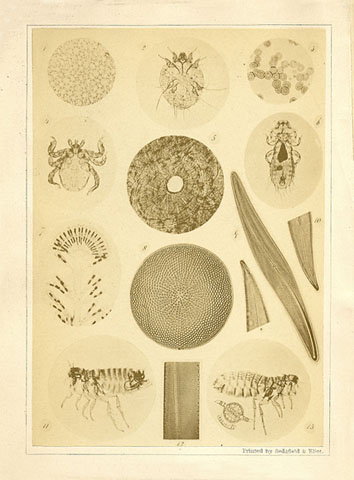
Third revised and enlarged edition:
Philadelphia, Lindsay and Blakiston, 1865.
London: Harrison.
xvi, 272pp., 3. adv.
Illustrated: mounted albumen frontispiece, 56 inserted lithographic plates.
Photographer: Dr. Richard Leach Maddox.
22 cm.
Subject: anatomy, microscopy.
Gernsheim, Helmut Incunabula of British Photographic Literature: number 421, The fourth edition contains a photographic frontispiece which combines several photo-micographs by Dr. R. L. Maddox, and printed by R. Sedgfield.
Beale held the position of Professor of Physiology and General and Morbid Anatomy at King's College London. If his name is obscure today it is because he contributed only in small measures to the science of medicine but these measures are so numerous Beale must be regarded as one of the pillars in the field of anatomy. He authored over 100 works including this important treatise on microscopy which ran through five editions.
Commencing with the third edition, Beale included a greatly enhanced chapter on photography comprising over forty pages of detailed procedures and diagrams as they were supplied to him by his friend Dr. Richard Leach Maddox who also contributed the mounted albumen frontispiece. Maddox is important for his innovation of a sensitized gelatin which soon replaced collodion as an emulsion and made possible the versatilty of dry plate photography. It is an indication of his generosity of spirit that Maddox did not patent his invention and eventually died honored but poor. One is reminded of the magnanimity of another doctor, Oliver Wendell Holmes, who bequeathed his popular stereoscope to the public domain with no thought of reward.

For the beautiful photograph which forms the frontispiece the author is indebted to his friend Dr. Maddox, who has also afforded him very great assistance in writing the chapter on photography. This is one of the most valuable chapters in the book. It contains the results of many years' most earnest work by one of the most successful workers in this department of photography. The detail of some of the photographic illustrations is so very minute, that many points cannot be seen by the unaided eye. A lens of low magnifying power has therefore been appended to the volume, to enable the reader to see the beautiful microscopical details which have been obtained by this mode of illustration, in which Dr. Maddox is striving to achieve still greater success.
